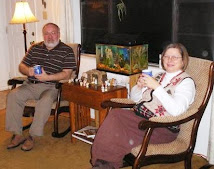
An
alpaca is a domesticated South American mammal, related to the llama and having fine, long wool. It is one of four New World
camelids (the family to which camels belong). Alpaca derives from the
Aymara language (yeah, if you want more information about that language, follow the link. It is one of only a few native American languages with over a million speakers—actually,
Aymara has over two million). The word camel goes all the way back to the Hebrew
gamal.

The alpaca is closely related to (in fact, descended from) the
vicuña. Here's a picture of these wild animals, who inhabit the high Andes. The word vicuña comes from the
Quechua, the language of the ancient Inca empire, which is spoken to this day by over eight million people in six south American countries.

The
paco vicuña is a cross between the gentle, domesticated alpaca and the wild vicuña. The fiber from the paco vicuña is of such high quality and so expensive that it was once reserved for Incan royalty. For more information about the paco vicuña, check out this
article.

The
llama is the best known of the South American camelids. There is a cute story about how the llama got its name. I originally read it in the book
Native Tongues by Charles Berlitz. The story goes that when the Spaniards first came to South America and encountered the llama, they asked what it was called (in Spanish
“¿Como se llama?”) Supposedly, the natives were confused and repeated the word llama over and over, convincing the questioners that the creature was called a llama!

Whether or not I like this story is immaterial. It seems that the story is
apocryphal. Apparently, the
Quechua word for llama is a word that sounds like—you guessed it—llama. So when the Spaniards asked the natives
“¿Como se llama?” obviously asking what the animal was called, the natives responded,
“Llama”!

Speaking of “what is this called” gives me an excuse to write about names and naming. We often think of names as arbitrary labels stuck on things to identify them. In fact, names are often closely associated with the inherent characteristics of the thing named. In Hebrew the phrase we translate “to name” is literally “to call its (his or her) name.” The naming of the animals was the assignment of a Hebrew word reflecting the basic nature of each animal. It wasn’t that the name was an arbitrary designation given by Adam but that Adam called the name (i.e. identified the name) of each animal.
Moreover, when reading about the naming of people in scripture, we find that the process of naming is one of calling into being the inherent nature or character of an individual, either in consonance with an event associated with the birth or as a prayer or prophecy of the future of the individual. In many cultures, names are carefully chosen to provide the maximum possibility of a good and prosperous future.
These are just a few thoughts about naming, a subject about which volumes could be (and have been) written. For just one, check out Marcia Prager's wonderful book
The Path of Blessing.
The fourth, lesser known, and wild South American camelid is the
guanaco. The name derives from a similar word in Quechua.

A year ago, I posted a little recap of our visit to the Estes Park Wool Market, which we visited last year with our daughter, Hannah. It was a fascinating day. You can read about it
here. Over the course of the past year, I have noticed that I receive many hits from people looking for information and/or pictures of the South American camelids. That had something to do with my choosing alpaca as a word to highlight, but also I just think these animals are the most fascinating creatures.
Incidentally, there is still time to make it to the 2008 iteration of the
Estes Park Wool Market, which is being held this weekend, June 14-15, 2008.














































